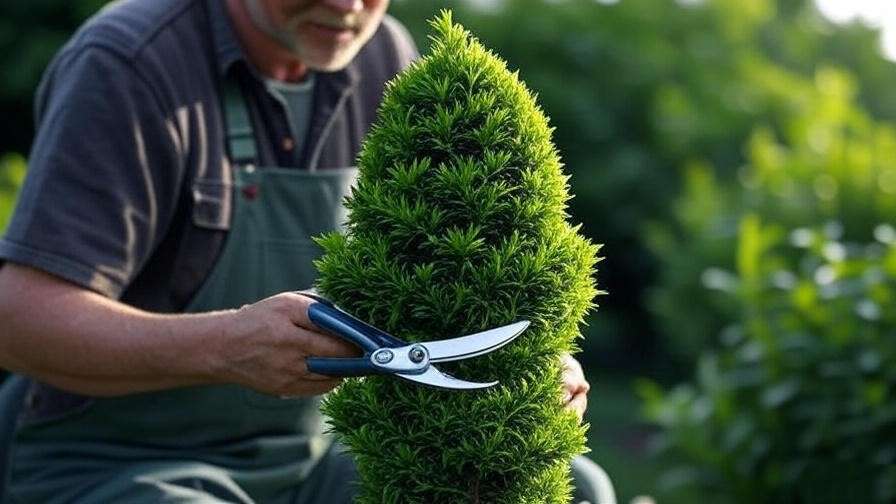Imagine transforming your garden into a masterpiece with a single, elegant spiral tree 🌿. These sculptural evergreens, with their mesmerizing helical shapes, are stealing the spotlight in modern landscaping. Whether you’re a novice gardener or a seasoned plant enthusiast, mastering the art of growing and maintaining a spiral tree can elevate your outdoor space to new heights. This comprehensive guide, crafted with decades of arboriculture expertise, delivers everything you need to know about spiral trees—from selecting the perfect variety to shaping and caring for it year-round. Get ready to create a stunning focal point that’s both low-maintenance and breathtakingly beautiful! 🌲
Our goal is to empower you with practical, expert-driven advice to grow a healthy, perfectly shaped spiral tree. We’ll cover every step, from planting to pruning, while addressing common challenges and offering design inspiration. Backed by industry-standard practices and insights from professional landscapers, this guide ensures your spiral tree thrives in any garden or patio setting. Let’s dive in and bring your vision to life! 🌱
What Is a Spiral Tree? Understanding This Unique Garden Feature 🌲
Definition and Appeal
A spiral tree is a topiary crafted into a graceful, helical shape, typically using evergreen shrubs or trees like boxwood, juniper, or cypress. These living sculptures add a touch of sophistication to gardens, patios, or entryways, blending artistry with nature. Their compact, structured form makes them ideal for small spaces, while their evergreen foliage ensures year-round beauty. Spiral trees are popular for their ability to serve as eye-catching focal points or elegant accents in formal and contemporary landscapes alike.
Popular Tree Varieties for Spiral Shaping
Not all trees are suited for spiral topiary, but certain species excel due to their dense foliage and slow growth. Here are some top choices:
- Boxwood (Buxus sempervirens): Known for its dense, small leaves and adaptability to shaping. Ideal for USDA zones 5-8.
- Dwarf Alberta Spruce (Picea glauca ‘Conica’): A compact conifer with soft needles, perfect for colder climates (zones 2-7).
- Juniper (Juniperus scopulorum): Hardy and drought-tolerant, great for sunny landscapes (zones 3-7).
- Yew (Taxus baccata): Versatile with dark green needles, thrives in partial shade (zones 4-7).
Each variety offers unique textures and growth habits, so choosing the right one depends on your climate and aesthetic goals.
Why Choose a Spiral Tree?
Spiral trees combine elegance with practicality. Their benefits include:
- Low Maintenance: Once shaped, they require minimal pruning to maintain their form.
- Year-Round Appeal: Evergreen varieties stay vibrant through all seasons.
- Versatility: Perfect for containers, small gardens, or as statement pieces in larger landscapes.
For gardeners seeking a solution to elevate their outdoor space without constant upkeep, spiral trees are an ideal choice. They address the need for a striking yet manageable garden feature, making them a favorite among homeowners and landscapers.
Getting Started: Choosing the Right Spiral Tree for Your Garden 🌱
Factors to Consider When Selecting a Tree
Selecting the perfect spiral tree starts with understanding your environment and goals. Consider these factors:
- Climate Compatibility: Check your USDA hardiness zone to ensure the tree thrives. For example, boxwood struggles in extreme heat, while junipers tolerate drought.
- Size and Space: Spiral trees range from 2-6 feet tall. Measure your space, especially for container-grown trees, to avoid overcrowding.
- Growth Rate: Slow-growing varieties like yew are easier to maintain, while faster-growing junipers may need more frequent trimming.
Buying a Pre-Shaped Spiral Tree vs. DIY
You have two options: purchase a pre-shaped spiral tree or create one yourself. Here’s a breakdown:
- Pre-Shaped Trees: Available at nurseries, these save time and ensure a professional look. However, they can be expensive ($50-$300 depending on size).
- DIY Shaping: Starting with a young, unshaped tree is cost-effective and rewarding but requires patience and skill. A young boxwood or spruce costs $10-$30.
Comparison Table: Spiral Tree Varieties
| Variety | Growth Rate | Hardiness Zone | Ideal Conditions |
| Boxwood | Slow | 5-8 | Partial shade, moist soil |
| Dwarf Alberta Spruce | Slow | 2-7 | Full sun, well-drained soil |
| Juniper | Moderate | 3-7 | Full sun, drought-tolerant |
| Yew | Slow | 4-7 | Shade-tolerant, rich soil |
Expert Tip: Visit a local nursery to see mature spiral trees in person. This helps you visualize how a specific variety will look in your garden.
Step-by-Step Guide to Planting a Spiral Tree 🌍
Preparing the Site
Proper site preparation is critical for a healthy spiral tree. Follow these steps:
- Soil: Ensure well-draining, loamy soil with a pH of 6.0-7.0. Amend clay or sandy soils with compost to improve drainage and fertility.
- Sunlight: Most spiral tree varieties prefer full sun (6+ hours daily), though yews tolerate partial shade.
- Tools: Gather a shovel, compost, mulch, and stakes for support (if planting a larger tree).

Planting Process
- Choose the Right Time: Plant in spring or early fall to allow roots to establish before extreme weather.
- Dig the Hole: Make it twice as wide and as deep as the root ball.
- Amend the Soil: Mix in compost or organic matter to enrich the planting site.
- Position the Tree: Place the tree in the hole, ensuring the root crown is level with the soil surface.
- Backfill and Water: Fill the hole, tamp down gently, and water thoroughly.
- Mulch: Apply 2-3 inches of organic mulch (e.g., bark or wood chips) to retain moisture and regulate soil temperature.
For container planting, choose a pot with drainage holes and use a high-quality potting mix designed for evergreens.
Watering and Initial Care
- First Year: Water deeply once a week, adjusting based on rainfall. Aim for 1-2 inches of water weekly.
- Avoid Overwatering: Check soil moisture before watering to prevent root rot.
- Staking: For taller trees, use stakes to stabilize against wind until roots establish (6-12 months).
Expert Insight: According to the University of Maryland Extension, consistent watering in the first year is key to reducing transplant shock and promoting healthy root growth.
Shaping Your Spiral Tree: Techniques for a Perfect Spiral ✂️
Tools You’ll Need
To shape a spiral tree, gather these essentials:
- Pruning shears (for precise cuts)
- Hedge trimmers (for larger branches)
- Wire frame or string (to guide the spiral)
- Gloves and safety glasses (for protection)
Safety Tip: Always sterilize tools with rubbing alcohol to prevent disease spread.
Creating the Spiral Shape
Shaping a spiral tree is an art form, but with patience, anyone can master it. Here’s how:
- Mark the Spiral: Wrap a string or ribbon around the tree in a helical pattern to outline the shape. Alternatively, use a pre-made wire frame.
- Initial Cuts: Start at the base, trimming away foliage outside the marked spiral. Work slowly, stepping back to check symmetry.
- Refine the Shape: Use shears to fine-tune the spiral, ensuring smooth, continuous lines.
- Timing: Prune in late winter or early spring before new growth begins. Avoid pruning during extreme heat or cold.

Maintaining the Spiral Over Time
- Frequency: Trim 2-3 times per year to maintain the shape, typically in spring and late summer.
- Avoid Over-Pruning: Remove no more than 20% of foliage at once to prevent stress.
- Check for Damage: Inspect for broken branches or pest issues during each trimming session.
Expert Tip: Create a simple diagram (or describe one for readers) showing the spiral pattern from top to bottom. This visual aid helps beginners visualize the process.
Ongoing Care for a Healthy Spiral Tree 🌞
Watering and Fertilizing
Proper watering and fertilizing are essential to keep your spiral tree vibrant and healthy. Here’s how to do it right:
- Watering Needs: Once established, most spiral trees require watering every 7-10 days, depending on climate and rainfall. In hot, dry conditions, increase to twice weekly, ensuring the soil stays moist but not waterlogged. For container-grown trees, check the top inch of soil; water when it feels dry.
- Fertilizing: Apply a balanced, slow-release fertilizer (e.g., 10-10-10) in early spring to support new growth. For organic options, use compost tea or fish emulsion every 4-6 weeks during the growing season (spring to early fall). Avoid fertilizing in late fall or winter to prevent stressing the tree.
- Soil Testing: Test soil annually to monitor pH and nutrient levels. Most evergreens prefer slightly acidic soil (pH 6.0-7.0). Amend with sulfur or lime if needed.
Expert Tip: Over-fertilizing can burn roots, so follow package instructions carefully and dilute liquid fertilizers to half-strength for young trees.
Pest and Disease Management
Spiral trees, like all evergreens, can face pest and disease challenges. Proactive care keeps them thriving:
- Common Pests:
- Spider Mites: Look for webbing or stippled leaves. Spray with a strong jet of water or use insecticidal soap for organic control.
- Scale Insects: Small, waxy bumps on branches. Apply neem oil or horticultural oil in early spring to suffocate them.
- Bagworms: Small, bag-like structures on foliage. Remove by hand and destroy, or use Bacillus thuringiensis (Bt) for organic treatment.
- Diseases:
- Root Rot: Caused by overwatering or poor drainage. Ensure proper soil drainage and avoid water pooling around the base.
- Leaf Spot: Fungal disease causing dark spots on leaves. Improve air circulation and apply a copper-based fungicide if needed.
- Preventative Measures: Maintain proper spacing between plants, prune dead branches promptly, and inspect regularly for early signs of trouble.
Expert Insight: The Royal Horticultural Society recommends monthly inspections during the growing season to catch pests early, reducing the need for chemical treatments.
Winter Care for Spiral Trees
Winter can be tough on spiral trees, especially in colder climates. Protect them with these strategies:
- Mulching: Add a 2-3 inch layer of mulch around the base to insulate roots and retain moisture. Avoid piling mulch against the trunk to prevent rot.
- Burlap Wraps: In windy or snowy areas, wrap the tree in burlap to shield it from drying winds and heavy snow.
- Anti-Desiccant Sprays: Apply in late fall to reduce moisture loss from foliage, especially for exposed trees in zones 4-6.
- Container Trees: Move potted spiral trees to a sheltered location (e.g., near a building or under a porch) or wrap pots in bubble wrap to insulate roots.
Expert Tip: For dwarf Alberta spruce, mist foliage lightly during dry winter days to prevent needle drop, especially in containers.

Design Ideas: Incorporating Spiral Trees Into Your Landscape 🏡
Spiral Trees in Garden Design
Spiral trees are versatile design elements that enhance any outdoor space. Consider these placement ideas:
- Entryways: Flank your front door with two spiral trees in matching containers for a symmetrical, welcoming look.
- Garden Borders: Use smaller spiral trees to define garden beds or pathways, adding structure to informal landscapes.
- Focal Points: Place a tall spiral tree in the center of a lawn or courtyard to draw the eye and anchor the design.
Pair spiral trees with complementary plants like lavender, roses, or low-growing groundcovers (e.g., creeping thyme) to create contrast and texture.
Container Gardening with Spiral Trees
For small spaces or urban gardens, spiral trees shine in containers:
- Pot Selection: Choose a pot at least 18-24 inches wide with drainage holes. Terracotta or fiberglass pots work well for stability and aesthetics.
- Soil Mix: Use a well-draining potting mix with perlite or vermiculite to prevent waterlogging.
- Placement: Position on patios, balconies, or near seating areas for maximum impact. Rotate pots every few months to ensure even sunlight exposure.
Design Tip: Add colorful annuals like pansies or marigolds around the base of the pot for a pop of seasonal color.

Seasonal Decorating
Spiral trees are perfect for year-round decor, especially during holidays:
- Holiday Lights: Wrap mini LED lights around the spiral for a festive glow during winter holidays.
- Ornaments: Hang lightweight ornaments or ribbons for special occasions like Christmas or garden parties.
- Year-Round Appeal: Maintain a polished look by regularly trimming and cleaning the base of debris.
Case Study: A homeowner in Seattle transformed their small courtyard by placing two 4-foot boxwood spiral trees in sleek black planters on either side of their patio. Paired with white gravel and purple salvia, the setup created a modern, low-maintenance oasis that earned compliments from neighbors.
Common Mistakes to Avoid When Growing Spiral Trees 🚫
Over-Pruning or Incorrect Shaping
Overzealous pruning can ruin a spiral tree’s shape or stunt its growth:
- Mistake: Cutting too much foliage at once, leaving bare patches.
- Solution: Trim lightly (no more than 20% of foliage) and allow 6-8 weeks for recovery before pruning again.
- Fixing Misshapen Trees: For uneven spirals, use a wire frame to guide regrowth and prune gradually over multiple seasons.
Neglecting Soil or Water Needs
Poor soil or watering practices can weaken your tree:
- Mistake: Planting in compacted or poorly draining soil.
- Solution: Test soil drainage by digging a 12-inch hole, filling it with water, and ensuring it drains within 2-4 hours. Amend with compost if needed.
- Mistake: Inconsistent watering, leading to drought stress or root rot.
- Solution: Use a moisture meter for precise watering, especially for container trees.
Ignoring Pests and Diseases
Neglecting early signs of trouble can lead to severe damage:
- Mistake: Overlooking yellowing leaves or webbing, assuming it’s normal.
- Solution: Inspect monthly and act immediately if pests or disease appear. Use organic treatments first to minimize environmental impact.
- Preventative Checklist:
- Ensure proper spacing for air circulation.
- Clean up fallen leaves to reduce fungal spores.
- Apply neem oil in spring as a preventative measure.
Expert Tip: Keep a journal to track pruning, watering, and pest treatments. This helps identify patterns and prevent recurring issues.

FAQs About Spiral Tree Care ❓
Q1: How often should I prune my spiral tree to maintain its shape?
A: Prune 2-3 times per year, ideally in late winter, early spring, and late summer. Light trims maintain the spiral without stressing the tree.
Q2: Can I grow a spiral tree indoors?
A: Yes, small spiral trees like boxwood or dwarf spruce can thrive indoors if placed near a bright window with 6+ hours of indirect light. Use a well-draining potting mix and mist regularly to maintain humidity.
Q3: What’s the best time of year to plant a spiral tree?
A: Spring or early fall is ideal, allowing roots to establish before extreme heat or cold. Avoid planting in summer or deep winter.
Q4: How do I protect my spiral tree from pests organically?
A: Use neem oil, insecticidal soap, or introduce beneficial insects like ladybugs. Regular inspections and proper pruning also prevent pest buildup.
Q5: Can I create a spiral shape from any tree?
A: Not all trees are suitable. Choose dense, slow-growing evergreens like boxwood, yew, or juniper for best results. Avoid fast-growing or sparse trees like pines.
Conclusion: Elevate Your Garden with a Spiral Tree 🌟
A spiral tree is more than a plant—it’s a living work of art that transforms your garden into a stunning showcase. With the right variety, planting techniques, and care, you can create and maintain a perfect spiral tree that thrives year-round. This guide has equipped you with expert tips, from selecting the ideal tree to shaping it with precision and protecting it from pests. Whether you’re enhancing a small patio or designing a grand landscape, your spiral tree will be a conversation starter for years to come.
Ready to get started? Use these proven strategies to grow a healthy, eye-catching spiral tree with confidence. Share your progress or questions in the comments below, and inspire others by posting photos of your masterpiece on social media! 🌳













